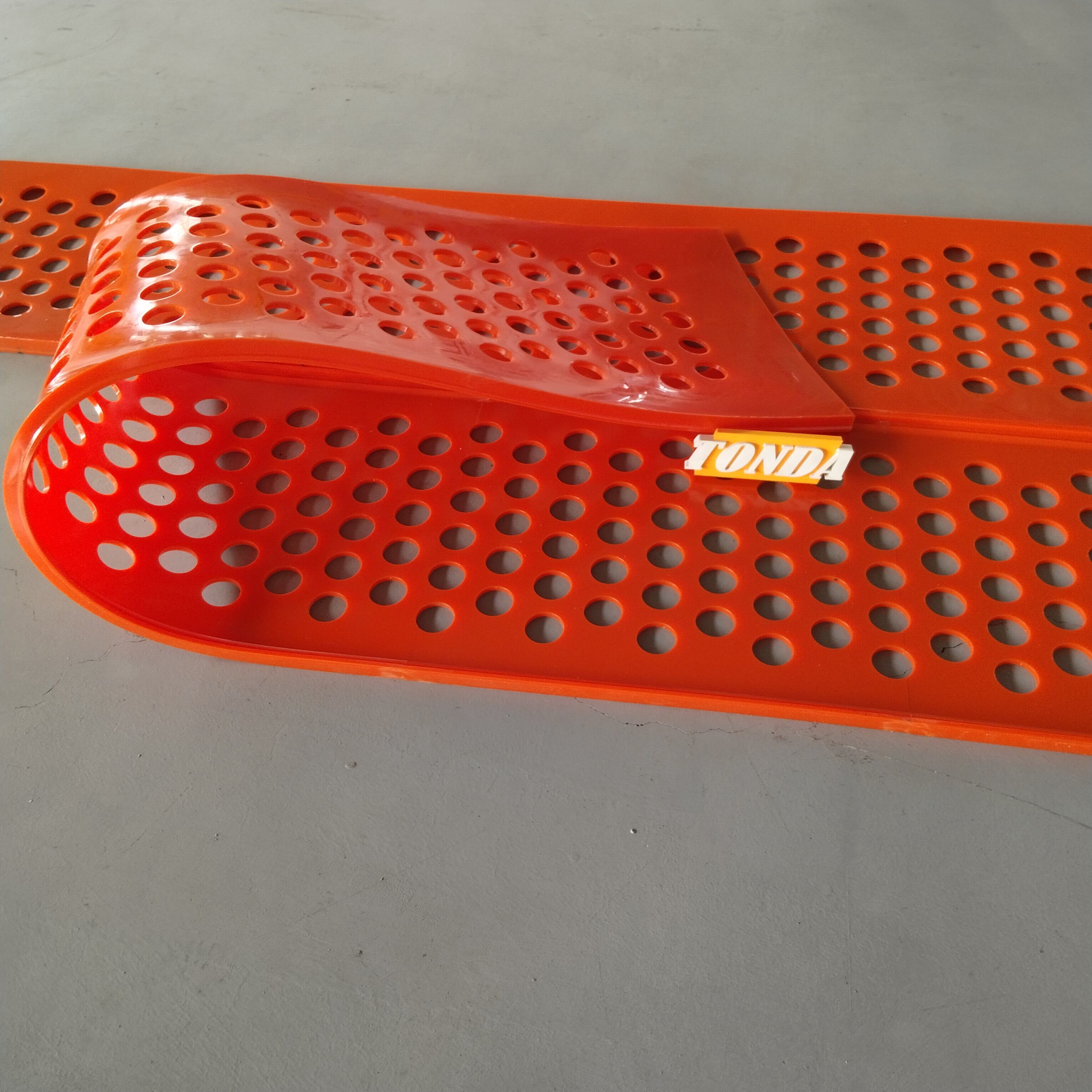Პოლიურეთანის რელაქსაციული ეკრანების ძირითადი მექანიზმი
Ვიბრაციული დინამიკა გაფиლტრების ოპერაციებში
Ვიბრაციული დინამიკის კონცეპცია ძალიან მსგავსია მოდერნულ ინდუსტრიულ ფილტრაციის ტექნოლოგიის სანახავად, როგორც კაბაჩის გადატანის. და მოდულირებით ვიბრაციული სიმძიმე და სიხშირე, ჩვენ კონტროლირებთ მასალის სტრატიფიკაციას – ნაწილები განსხვავდებიან ზომის და სიმჭიდროვნეს მითითებული მიხედვით, და ჩვენ ეფექტურად განსხვავდებით. უმეტესი სიხშირე წვდომადია უკეთ ფილტრაციისთვის მცირე ნაწილებისთვის, ხოლო უმეტესი ამპლიტუდა დაგვეხმარება მცირე მასალების გაფილტრებასა და დიდი ნაწილების განსხვავებას. ეს ვიბრაციული პარამეტრებისა და ნაწილების განსხვავების ეფექტიურობა შესაბამისია: შესაბამისი დინამიკით, ნაწილები განსაზღვრებულია უფრო ეფექტურად, ამავე გაზრდით გადასაყვან სიჩქარე.
Პოლიურეთანის როლი სტრესის განაწილებაში
Პოლიურეთანის ეკრანები გარკვეულია მუდმივი წნევის განაწილებისთვის ეკრანის სრულ ზედაპირზე მუშაობის განმავლობაში. ეს წნევის განაწილება გარკვეულია ეკრანის პანელების არსებითი ნორმალიზაციისთვის, რაც განახლების პერიოდს განგრძელებს. პოლიურეთანი წარმოადგენს მდებარე წნევის წერტილებს, რაც წვდომის დროს მცირე დახარჯების შესახებ განახლების ღარიბობას შეიცვალებს. მაგალითად, ინდუსტრიები, რომლებიც გამოყენებენ პოლიურეთანის ეკრანებს, შენიშნავს, რომ ეფექტური წნევის მenedžmentი პროცესურ აღარის მართვაში შეიძლება ჩატარდეს ისეთი საინტერესო საშუალებები, როგორიცაა დაბალი დახარჯი მართვისთვის, გრძელი განახლების ინტერვალები და გაუმჯობესებული მართვა და დახარჯების შენახვა.
Ინტერაქცია წრფივი ვიბრაციული ეკრანის სისტემებთან
Პოლიურეთანის რელაქსაციული ფილტრები მუშაობენ სრულყოფილად წრფივ ვიბრაციულ გაფილტრების მანქანაზე კვარცის ქარისთვის და დახმარებით გაიზარდება მუშაობის ეფექტი. პოლიურეთანის ფილტრები გაძლევენ მაღალ მოწყობილობას, რათა მასალა გადაადგილებულიყო ფილტრის მეშვეობით უფრო მომავალად და მცირე ჩაკიდებით, რაც განსაზღვრული გამოქვეყნებისგან და შეწყვეტებისგან დაცული გარემო გაუზარდება. სასარგებლობა არის ნახევარი: ნაკლები ხარჯადი გამოქვეყნებები და უკეთესი სორტირების ზუსტება. ეს კომბინაცია გამოყენებულია განსაკუთრებით მრავალ ინდუსტრიებში, რადგან მას აქვს უფრო ძალიანი და გრძელმდებარე ბუნება და საშუალება წრფივ ვიბრაციულ გაფილტრების სისტემების მიმართ უფრო საშიში და საშუალება. ისინი ხელახლა განხილულია სრულყოფილი ხარისხით, რათა დაადგინოს ეს სინერგია სამიზანო გაფილტრების აპლიკაციების კონტექსტში, გამავალი ეფექტივობისა და მართვის სტანდარტების გაუმჯობესებით.
Ძირითადი კომპონენტები და მასალის თვისებები
Პოლიურეთანის ელასტიურობა და გაჭრივი ძალა
Პოლიურეთანის მაღალი ელასტიურობა და წვეთოვანი სიმტკიცე აუცილებელია მისი გამოყენებისთვის საფილტრაციო ფუნქციის შესრულებაში. ეს თვისებები უზრუნველყოფს მას სტრესისა და დეფორმაციის წინააღმდეგ წინააღმდეგობას, ხოლო ასევე საშუალებას გვაძლევს მოვაწყოთ სხვადასხვა ზომის ამოღებები და უკეთ შევინარჩუნოთ ფორმა მავთულის კვადრატული ამოღებების შედარებით. ეს გაძლევთ საჭირო პროდუქტს, რომელიც უფრო მეტ ხანს გაგრჩებათ და შეამცირებს დროს, რომელიც ხარჯავდება მავთულის გამოცვლაზე, ასევე შეამცირებს საფილტრაციო მოწყობილობებთან დაკავშირებულ ხარჯებს. მაგალითად, პოლიურეთანის ელასტიურობა გამოიხატება მეგაპასკალებში (MPa), რაც აღემატება ალტერნატიულ მასალების უმეტესობას, როგორიცაა რეზინი ან ლითონი, ამიტომ ის უფრო მეტად მდგრადია საწარმოო პირობების მიმართ. ეს დამატებითი წვეთოვანი სიმტკიცე დაგეხმარებათ დაამციროთ მანქანის ადრეული გახსნისა და დახვევის რაოდენობა ეკრანის გადაღუნვისა და გამრუდების შეჩერებით.
Ღირებული სტრუქტურა ნაწილაკების მოსვლის გარკვევისთვის
Პოლიურეთანის ღირბიტაში გახსნილი უჯრედის ფორმაცია წარმოქმნილია გამოსავლის ეფექტი, რომელიც გაუმჯობეს ნაწილაკების ჩასმა გამოსადილების პროცესში. გახსნილი უჯრედის კონფიგურაციას შედარებით დახურული უჯრედის ვარიანტებს, უფრო მარტივი ხდება ნაწილაკების გადიანა ფომში, რაც მინიმიზებს ჩამორჩენას და გაუმჯობეს გამოსავლის სიჩქარე. ნაწილაკების გამოსავლის ოპტიმიზაცია ძველია მანქანების ეფექტურობის მარტივი და გაუმჯობეს დროის დაკარგვას არაგეგმილი დაგეგმული დარღვევის გამო. გამოყენების შემდეგ გახსნილი უჯრედის სტრუქტურის პოლიურეთანის გამოსადილებზე, მოხარდალია, რომ წარმოება ძალიან გაიზარდება სტანდარტული პოლიურეთანის გამოსადილების შედარებით, ამიტომ ეს სტრუქტურული მახასიათებელი ჩანაწერია ინდუსტრიაში.
Ქიმიური წამალება მრავალფეროვან გარემოებში
Პოლიურეთანი სუფთა ოთახი და ქიმიკატების მიმართ გამძლე პოლიურეთანი ასევე შეიძლება იყოს უზრუნველყოფილი და შესანიშნავი არჩევანია ყველაზე მძიმე სამრეწველო გარემოში. ეს არის მდგრადი აგრესიული ნივთიერებების გამოყენების ტრადიციული ეკრანის გაწმენდა და ეს დაიცავს მათ წინააღმდეგ დღეში დღე. ბევრი ინდუსტრიული ქიმიკატები, მათ შორის, როგორც აღვნიშნეთ, გამხსნელები და მჟავები, მნიშვნელოვნად შეამცირებენ მეტალის და რეზინის ეკრანების მოხმარების ხანგრძლივობას, მაგრამ პოლიურეთანი უზრუნველყოფს ძალიან ძლიერ რეაქციას. ინდუსტრიის კვლევების თანახმად, პოლიურეთანი უკეთ ინარჩუნებს თავის სტრუქტურულ თვისებებს ქიმიურად აგრესიულ გარემოში და აღინიშნება მისი გამძლეობისა და შესრულების გამო ყველაზე მძიმე პირობებში.
Მიმართულებები ჩვეულებრივ ეკრანების მეთოდებზე
Შეადგილებული აპერტურების გარეშე გამოყენების შემცირება
Პოლიურეთანის ეკრანები მქონდა თვითმატარებელ გახატვებს და გადაწყვეტილია, რომ გარკვეული 10-ჯერ უფრო გრძელი გარდაიტანენ, შედარებით საწყვეტი საჭირო საღამოს ეკრანებზე, რაც შემცირებს ხარჯებს და შესაძლებლობას მცირე დადგურებისთვის. ამ დიზაინის გამოყენებით მასალების გასვლა იქნება უფრო ეფექტური და მცირე იქნება ჩაკიდების მოქმედება, რაც ნიშნავს, რომ მეტი მენტენანს არ იყოს საჭირო. შედეგად, მუშაობის დადგურები მინიმალიზებულია და ზოგადი პროდუქტიურობა და ეფექტიურობა იზრდება. ინდუსტრიის წყაროები ამბობენ, რომ კომპანიები, რომლებიც გადავიდნენ პოლიურეთანის ეკრანებზე, გამოიყენეს საკმარისი ზრდა პროდუქტიურობაში და მენტენანს ხარჯების შემცირება.
Გაზრდილი სერვისის პერიოდი მეტალურGI ეკრანების შედარენ
Პოლიურეთანის ეკრანები გამოჩენილია გრძნობის გარდა, ვიდრე სხვა ტიპის ეკრანული მასალა. მათ ნატურალური წარმოღების წინააღმდეგობა ასახავს დამატებით სარგებლობას. პოლიურეთანის მასალის განვითარების შემდეგ, ეკრანები მიღებულია განვითარებული ელასტიურობით, რაც გარანტირებს, რომ მათ არ გახდება ხარში ან ალუმინიზაცია ყველა მუშაობის პირობებში. ინდუსტრიის შეფასებები ჩვენებს, რომ ეკრანები მართლაც გრძნობის გარდა გაქვთ; მათ გრძნობა შეიძლება იყოს მთელი თვეები გრძნობის გარდა, ვიდრე ნებისმიერი მეტალურგიული ეკრანი. ეს გრძნობის გაზრდა ნიშნავს ნაკლებ ხშირი ჩანაცვლებას და დაბალი მართვის ხარჯები, რაც მათ ხდის ეკონომიური ალტერნატივა გრძელი პერიოდისთვის.
Шумის შემცირება ლინეარული ვიბრაციული ეკრანების გამოყენებაში
Პოლიურეთანის ეკრანი, რომელიც მilikiს კარგ შუქის დაბრუნების ეფექტს, არის იდეალური ამოხსნა იმ პირობებისა, სადაც შუქი არის პრობლემა. პოლიურეთანის მასალის საკმარისი დამალვა და ელასტიურობა მინიმიზებს ვიბრაციებს, რაც, თანამედროვე, უზრუნველყოფს უფრო ნიშნავ მანქანების მუშაობას და ასევე მniejsს მუშაობის მოწინააღმდეგობას ან შუქის გამოწვევით დარღვევას ან ინვალიდობას. ეს არის დამატებითი მეთოდი სამუშაო გარემოს მართვისთვის მუშადებლების ჯანმრთელობისა და სამართლის გარემოში. ინდუსტრიული კონსულტაცია: "ექსპერტებმა ერთმანეთთან ეთანახა შუქის გამოსახატებლად საჭიროა დაუზუსტოთ მუშაობის სამართლი. გამოსახატებელია საჭიროება ნაკლებად შუქიან ეკრანების მეთოდების გამოყენებაც, სადაც განსაკუთრებით ჩანს ფარმაცევტული პროდუქტების ეკრანების სფეროში."
Ინდუსტრიული აპლიკაციები და მუშაობა
Მინერალური და მინერალური მუშაობის ეფექტიურობა
Დღეს პოლიურეთანის რელაქსაციის ეკრანები ყველა მეტი გამოიყენება მინინგის ინდუსტრიაში, განსაკუთრებით მინერალური მუშაობისას. ეს წარმოადგენს ძალ Gaussian ეფექტიულობას, რომელიც ამოიღებს ჩვეულებრივ გამოხატულ პრობლემებს, როგორიცაა გადაჭერა და ეკრანის არანახვა, რომლებიც მოიხსენება تقليსური მეტალური ეკრანებით. განიხილეთ, რომ მრავალი მინის სტატისტიკა ჩვენს მიერ ჩანაწერილია, რომ პოლიურეთანის ეკრანების გამოყენებისას, მომსახურება იზრდება და პროდუქტების მარტივობა იქნება უმეტესობით მეტი. რამდენიმე მინერალი, მაგალითად რკინის მინერალი და სასამართლო წყალი, ძალიან წარმატებული იყო ასეთი ეკრანებით, რომლებიც განაპირობა მინინგის მომსახურების გაუმჯობეს.
Რეციკლირება და მასალების განსაზღვრა
Პოლიურეთანის ეკრანები ბოლო წლების განმავლობაში გახდა უძველესი ნაწილი დეჰიდერირების ეკრანებისა და გადამუშავების სისტემების მრავალი ადამიანისათვის და გამოიწვია ეფექტურობის გაუმჯობესება და ხარჯების დაზოგვა ნარჩენების წარმოებული პროდუქტების, სამრეწველო ქვიშის ბაზრებზე და F ისინი გამორჩეულად გამოირჩევიან ტრადიციულ მეთოდებზე, განსაკუთრებით მინისა და პლასტმასის მასალებზე, სადაც წვრილმანი გაყოფა მნიშვნელოვანია. ამ მოწინავე ეკრანების გამოყენებით, სისუფთავე შეიძლება გაიზარდოს და ნარჩენები შეიძლება მინიმუმამდე იყოს მიყვანილი, რათა უზრუნველყოს ეკოლოგიური სარგებელი. უფრო ეფექტური პოლიურეთანული ეკრანები ასევე ხელს უწყობს რეციკლირების უკეთეს ძალისხმევას; ისინი მდგრადობის ნაწილია და ამცირებს რეციკლირების ოპერაციების გარემოზე ზემოქმედებას.
Ინტეგრაცია ტრანსპორტირების მოწყობილობებთან
Პოლიურეთანის გაფиლტრების ეკრანები შეიძლება იყოს დამზადებული გაფილტრების მაशინებში ან გაფილტრების მაशინებში, რაც ამ მაशინებს უზრუნველყოფს კითხვაში მეტად ეფექტურ სამუშაო. ამ გამარჯვება წვდომა აქვს სამუშაო ეფექტიურობის საკმარის გამართვებს, მათ შორის უფრო მარტივ გამოყენებასა და დანიშნული დროის შეკრებას, რაც ზრდის პროდუქტიურობას საერთოდ. სამეცნიერო და ფარმაცევტული სფეროები შორის მიიღებიან სანამართლო სისტემებისგან და გამოცდილიან სამუშაო ეფექტიურობისა და ინდუსტრიული სირთულის საკმარის ზრდას. ეკრანებისა და ტრანსპორტირების მასალების ეს სიმბიოზი ჩვენს თვალებში აჩვენებს პოლიურეთანის ვერსატილობას და გამოწვევას ინდუსტრიულ სფეროში.
Შენარჩუნებისა და ხანგრძლივობის გათვალისწინებები
Მართვის პროტოკოლები უმაღლესი პერმეაბილიტეთისთვის
Პოლიურეთანის ეკრანების უმაღლესი პერმეაბილიტეტის მართვა მათი ეფექტიურობასა და გარბენის გაუზარდნელად ძველი არის. მართვის პროტოკოლები უნდა იყოს მარტივად მიმდევრული, რათა არ წარმოქმნას მასალების ამაღლება, რომელიც შეიძლება დააზუსტოს მართვა. აქ არის ნაბიჯ-ნაბიჯი ეფექტური მართვისთვის:
- Პირველი გასარეული : დაიწყეთ მაღალ წნევის წყალის რინსით, რომ აშორისოთ გამოტანილი ნაწილები და ნახურველი.
- Დეტერგენტის გამოყენება : გამოიყენეთ მიღების ძალიან მიღების დეტერგენტი, რომ გადაჭრათ მუშა დეპოზიტები.
- Ჩიხის შრაბი : გამოიყენეთ მỀრცხადი ჩიხის ფერაში, რომ მიღებით გადაჭრათ ეკრანის ზედა ზედაპირობა.
- Საბოლოო გამრეწვალი : დაასრულეთ სრუoga გამრეწვალი, რომ აშორისობთ ნებისმიერ დარჩენილი დეტერგენტი.
Ამ პროტოკოლების მნიშვნელობა განსაზღვრება მეტრიკებით, რომლებიც ჩვენებს, რომ გასუფთავებული ეკრანები შეიძლება მათ საწყისი პერმეაბილიტის 98%-ზე მეტი შეინახონ, თუ მათ არ აქვთ ყურადღება.
Მონიტორინგი აღმოსავლეთის მოდელები მაღალი გამოსავლის სიტუაციაში
Სანახავი გამოწვევის მოდელის მთავარი მიზანია პოლიურეტანის ფილტრის სერვისის ცხოველის პროგნოზირება, განსაკუთრებით იმის, რომელიც მუშაობს მაღალი სიხშირის ვიბრაციულ ელემენტებში. აქტიული მonitorინგის საშუალებით შეგიძლიათ გამოიყენოთ გამოწვევა ისე, რომ არ გახდეს სისტემის მუშაობისთვის დაზღვევითი. მონიტორინგის ტექნოლოგიები, როგორიცაა ინფრაწითელი თერმოგრაფია ან ულტრასაouncი ტესტირება, შეიძლება გთავაზოს მიახლოებითი მონაცემები ფილტრის მდგომარეობის შესახებ. ექსპერტული მონაცემები ჩვენს მიერ დამტკიცებულია, რომ მონიტორები, რომლებიც მონიტორინგის გაკეთების შემდეგ მუშაობს რთულ გარემოში, შენახავენ 20%-ზე მეტს პროდუქციის ეფექტიურობაში და შემცირებენ ვადებს ისინი, რომლებიც შეიცვლენ საჭიროების მიხედვით, არა ვადის შემდეგ.
Სტრატეგიები უწყვეტელ მოქმედებისთვის
Სტრატეგიული ეკრანის შეცვლა შეიძლება იმPLEMENTდეს, რათა პრევენტირების გარეშე დახურვა წარმოეღებინათ და მუშაობა განუყოფილი იქნება. სიმძიმე მოდელების გამოსაჩერებლად და მოთხოვნის მოცულების შემთხვევაში მენტენანს დარჩება ზარდალის განრიგში. პრაქტიკები, როგორიცაა კრიტიკული ნაწილების შენახვა რეზერვში და ინდუსტრიული სტანდარტების მიმართული მძიმე ლიმიტების მიმართული, მნიშვნელოვანია. ეფექტური შეცვლის პროცესის გაუზ Gaussian-ის გარეშე დარღვევა თქვენს მუშაობაში, განადგურებთ მუშაობის მუშაობას, როგორც ინდუსტრიული ლიდერების სარჩევია პროაქტიული მენტენანსის გეგმირება.

